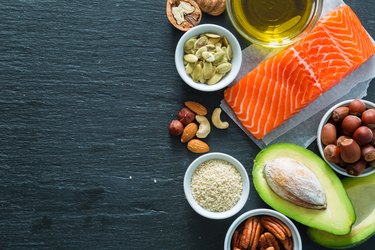
While there are a lot of diets that promise to help you drop weight fast, it's better to take it off slowly. Losing 10 kilos, or 22 pounds, takes at least two months, depending on your diet and exercise plan. It's advice you heard before, but reducing portion sizes and thus calorie intake, choosing healthy foods, and adding physical activity is the ticket to successful weight loss.
Video of the Day
Video of the Day
Reduce Your Calorie Intake
If you're trying to lose 10 kilograms, or 22 pounds, you need to eat fewer calories than your body burns daily. As Harvard Health Publishing points out, it's necessary to burn approximately 3,500 calories to torch one pound (0.5 kilograms) of fat. To lose 1/2 to one kilogram a week, you need to reduce your current calorie needs — the number of calories necessary to maintain your weight — by 550 to 1,100 calories a day.
Exactly how many calories you burn per day depends on a lot of factors, such as your metabolism, your activity level, your size and your body composition. Use an online calculator to get a rough estimate and then subtract 550 to 1,100 calories from that to determine your calorie intake for weight loss.
While you need to reduce your calorie intake to slim down, you shouldn't eat fewer than 1,200 calories a day if you're a woman or less than 1,800 calories if you're a man. Eating too few calories may slow down your metabolism and derail your weight loss.
As the U.S. Department of Health & Human Services notes, very-low-calorie diets require medical supervision. In general, these diet plans are only prescribed in extreme cases.
Make Smart Food Choices
Hunger is enemy number one when you're trying to lose those extra kilos. To fight back, eat foods that keep you full. These are usually high in protein, fiber and water.
Fruits, vegetables and broth-based soups are examples of foods with a low energy density. Small servings of whole grains, such as quinoa, barley and millet, are also good choices due to their fiber content. The fiber in grains takes longer to digest, delaying hunger. These foods increase satiety and suppress hunger, making it easier to stick to your diet.
You also don't want to skimp on protein. High-protein foods, such as lean meat, poultry, fish, low-fat dairy, soy and beans, help satisfy hunger better than carbs, according to Harvard Health Publishing. Protein takes longer to digest and forces your body to use slightly more calories.
Remember to watch your portions, though. Protein-rich foods are not calorie-free. If you eat more than you need, you'll end up gaining weight.
Be sure to include a serving of protein with each meal to keep hunger at bay. One large egg, for example, has more than 6 grams of protein. A single cup of nonfat milk provides 8.4 grams of protein. Cooked chicken breast (skin removed) boasts a whopping 26 grams of protein per serving.
Plan Your Meals and Snacks
Like your food choices, how often you eat is an important part of your diet plan when your goal is to lose 10 kilos. For energy and continued hunger control, eat three meals plus one to two snacks each day. Keep each meal about the same size. Serve high-protein foods with leafy greens, cucumbers, cruciferous vegetables and legumes — or whole grains.
Breakfast, for example, might be two hard-boiled eggs with a slice of whole wheat toast and a bowl of cantaloupe. Minestrone soup with a grilled chicken salad makes a healthy choice for lunch.
At dinner, fill up on broiled salmon, baked sweet potatoes and roasted asparagus. Nonfat yogurt, fresh fruit, veggie sticks, low-fat cheese or whole-grain crackers make good snack options.
Also, be sure to limit your intake of ultra-processed foods and beverages like soda, sweet tea, cookies, cake, candy and fried foods. These products are high in sugar and trans fats, increasing your calorie intake without offering any health benefits. When it comes to drinks, water makes the best choice.
Read more: 10 Body-Fat Burning Moves
Exercise for a Leaner You
Every good weight loss plan should include regular physical activity. Aerobic exercise, such as a brisk walk or a spin class, is a good way to burn off calories. Aim for 60 minutes of moderate-intensity exercise five days a week —a bike ride, jog or water aerobics classes are all great options.
One of the consequences of slimming down is the loss of lean muscle tissue. As you restrict calories, your body loses muscle along with fat.
Muscle helps your body burn calories, so limiting muscle loss can help you lose weight in a couple of ways. It can help prevent the plateau most dieters experience. Second, preserving lean body mass can keep your metabolism humming so you don't need to reduce your calories even further to continue losing weight.
You might be able to offset some of the muscle loss by including strength training in your fitness routine. Work each major muscle group — legs, abs, chest, shoulders, back and arms — twice a week using free weights, gym machines or resistance bands. Leave at least one day between strength training workouts to allow your muscles to recover.
- National Heart, Lung and Blood Institute: "Healthy Eating Plan"
- Centers for Disease Control and Prevention: "Low-Energy-Dense Foods and Weight Management: Cutting Calories While Controlling Hunger"
- Baylor College of Medicine: "Adult Energy Needs and BMI Calculator"
- American Academy of Nutrition and Dietetics: "4 Keys to Strength Building and Muscle Mass"
- Centers for Disease Control and Prevention: "How Much Physical Activity Do Adults Need?"
- Harvard.edu: "Simple Math Equals Easy Weight Loss"
- Harvard.edu: "Extra Protein Is a Decent Dietary Choice, but Don’t Overdo It"
- USDA: "Raw Eggs"
- USDA: "Nonfat Milk"
- USDA: "Chicken, Broilers or Fryers, Breast, Meat Only, Cooked, Roasted"
- NCBI: "Ultra-processed Food Intake and Obesity: What Really Matters for Health – Processing or Nutrient Content?"